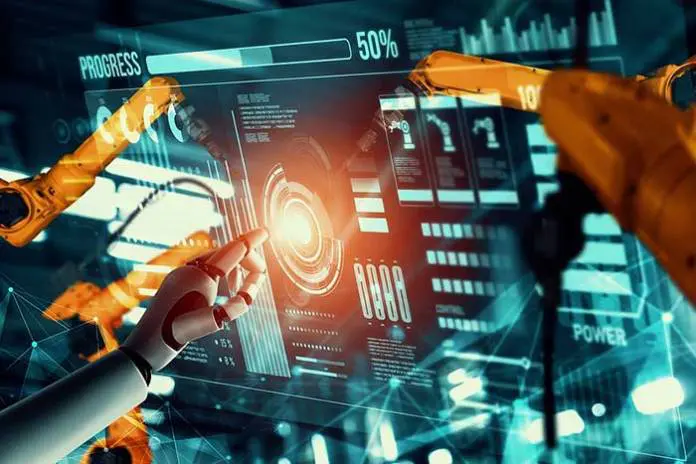
Robots are making their way into our lives — and in the best ways possible.
Many people have vacuumed robots in their homes and artificial intelligence systems to make their lives easier, but there are many ways robots are helping across the world and in different industries on more intricate levels.
Let’s explore five major industries that are taking advantage of the benefits that robotics has to offer.
Healthcare
The healthcare industry is using robots in many ways to increase productivity and limit the spread of germs. Medical assisting robots perform surgeries, run tests, complete various scans on the human body, and detect disease.
More specific ways robots are being used in the healthcare field is for assisting with and implementing surgeries. During surgery, robots can make more precise and smaller cuts than the steadiest human hand can; they can make incisions with minimal damage to the surrounding tissue and skin.
Robots are also being used to limit contact between patients and healthcare workers. In hospitals and doctor offices, robots are being used as a two-way communication device — better known as a Walkie Talkie system. A doctor can check in with sick or contagious patients without being in the room. Plus, using robots instead of physical doctor visits enables doctors to treat more patients per day and accomplish more administrative duties.
To limit the spread of germs, robots are also delivering prescriptions to patients to keep nurses out of harm’s way.
Oil and Gas
The oil and gas industry is another one leveraging robotics.
In the oil fields, robots are being used to lift heavy equipment, take over repetitive tasks, and replace workers when performing dangerous tasks such as robotic tank cleaning.
The traditional method of oil tank cleaning involves human crew members going into the confined spaces of the tank to clean the inner walls and remove sludge buildup manually. This tank cleaning process puts humans at risk in many ways — confined spaces, exposure to toxic fumes and chemicals, and low oxygen levels.
With robotic tank cleaning, the robots are the ones doing all the dirty work. The robots are remote-controlled off-site by crew members, but other than that, humans are removed from this dangerous process.
Automation and robotics are also assisting in keeping oil and gas sites safer for workers. Sensors and automation let workers know when machinery is is malfunctioning or requires maintenance.
Robotics is also being leveraged by helping to record and analyze massive amounts of data. Oil and gas rely heavily on data and analytics to make the best choices when it comes to drilling, excavating, and surveying sites. Analytics, artificial intelligence, and the use of the Internet of Things (IoT) enable plant and site managers to make smarter business decisions backed with facts rather than guesses or assumptions.
Agriculture
As the human population grows, the agriculture industry is always looking for ways to increase production and reduce costs. One way they are doing this is by leveraging robots.
Robots can help with mundane but necessary tasks like harvesting, mowing, spraying, and pruning through self-guided GPS systems. Sensor technologies are also being used to detect pests and disease outbreaks that harm crops so that farmers and property owners can catch these issues before they cause significant damage or harm.
According to the World Economic Forum, around 60% of agriculture tasks could be taken over by robotics and automation.
Military and Security
The military and security industries are also taking advantage of robotics to advance their defenses further, getting people out of harm’s way and improving tactics. Robots used in the military and security field come in all shapes and sizes; they are small enough to fit in air ducts, sturdy enough to fight fires, and fully autonomous or controlled off-site.
The military is currently using robots alongside human soldiers in combat. Robots can detect bombs, conduct reconnaissance, perform search and rescue, and send a more accurate shot than humans when shooting targets or missiles. All of these instances help protect soldiers and increase the efficiency of tasks.
Drones are being used to drop supplies to teams, conduct search and rescue missions, and detect landmines.
Automotive
The automotive industry includes many repetitive tasks that are easily being taken over by robots.
Robots and automation used during assembly processes lower labor costs, speed up productivity and keep humans away from potential risks when working with heavy machinery. Robots are also being used to paint, weld, and transfer parts.
Another way the automotive industry is utilizing robotics is through GPS, gauges, and warning sensors to detect machinery malfunctions or assembly issues before production gets too far along. On a larger scale, AI systems are being used for autonomous vehicles by companies like Tesla and BMW.
Robots Are the Future
According to Mordor Intelligence, “The Global Robotics Market was valued at USD 27.73 billion in 2020 and is expected to reach USD 74.1 billion by 2026,” so it’s safe to say that robots are here to stay, and we will be seeing more and more of them.
Robots are helping ensure workplace safety, reduce business costs, and increase productivity on massive scales. They’re taking over mundane jobs while working alongside human workers to assist with tasks.
With the pace of innovation we’re seeing, the robotics industry and its assistance to other sectors will undoubtedly continue to grow.











